In 2020, 607 child passengers* ages 12 and younger were killed in motor vehicle crashes in the United States,1 and more than 63,000 were injured.2 Of the children who were killed in a crash, 38%† were not buckled up.1 Parents and caregivers can make a lifesaving difference by ensuring that their children are properly buckled on every trip.
Age
Restraint use (like car seat, booster seat, or seat belt use) varies by age.
- Restraint use typically decreases as children get older.1,3–6
- 40%§ of 8–12-year-olds who were killed in crashes were not buckled up, compared with 31% of children less than 4 years old. These data are from a study published in 2020 using fatal crash data.1
- In a different study from 2019 where researchers observed children riding in cars, they found:
- 3% of children under age 1 were not buckled up
- 6% of children 1–3 years old were not buckled up
- 14% of children 4–7 years old were not buckled up
- 13% of children 8–12 years old were not buckled up.3
- Also, among children who are buckled up in child restraints, many graduate too soon to the next stage of child passenger safety. An example is when children stop using a booster seat before the seat belt fits them correctly. Age-appropriate restraint use typically decreases as children get older.7,8
Race and ethnicity
American Indian and Alaska Native children and Black children are more likely to be killed in a crash than White children.9,10
- Child passenger death rates were highest among American Indian and Alaska Native children (2.67 per 100,000 population), followed by Black children (1.96), according to combined data from 2015–2019.10
Several studies also indicate that it is more common for Black children,3–5,7,9,11Hispanic children,3,5,9,11,12 and American Indian and Alaska Native children11 to travel unrestrained or improperly restrained when compared with White children.
- 34% of Black children, 17% of Hispanic children, and 8% of White children ages 4–7 years were not buckled up, according to a study in 2019 where researchers observed children riding in cars.3
Rural versus urban location
Children in rural areas are typically at higher risk of being killed in a crash. According to combined data from 2015–2019:10
- Child passenger death rates were highest in the most rural counties (4.5 per 100,000 population) and lowest in the most urban counties (0.9).10
- Death rates among children who were not using age-appropriate restraints were highest in the most rural counties (2.9 per 100,000 population) and lowest in the most urban counties (0.5).10
Studies also indicate that children in rural areas are more likely to be incorrectly restrained than children in urban areas.8,13
- A multistate study using data from car seat check events found that child restraint misuse was more common in rural locations (91%) than in urban locations (83%).13
Alcohol-impaired driving
Alcohol-impaired driving is a major threat to all road users, including child passengers.1,14,15
- In 2020, 24% of deaths among child passengers (ages 14 and younger) involved an alcohol-impaired driver.14
- Among all child passengers (ages 14 and younger) who were killed in crashes, a higher proportion of those riding with alcohol-impaired drivers were unrestrained (56%)¶ compared with children riding with drivers who had no alcohol in their system (38%).1
- Other studies** have also found an association between driver alcohol use and child passengers being unrestrained.15,16 For example, one study among children under 2 years old who were killed in crashes found that the odds of the child being unrestrained were 2.2 times higher when the driver had been drinking alcohol than when the driver had not been drinking.16
Driver seat belt use
Restraint use among children is associated with their driver’s seat belt use.1,5–8,16–21
- In 2020, 65%†† of child passengers ages 14 and younger killed in crashes who rode with unbuckled drivers were also not buckled up, compared with 32% of children riding with buckled drivers.1
- Researchers who observed adults and children riding in cars in 2021 found that 95% of children ages 7 and younger who were driven by a buckled driver were restrained, compared with 77% of children driven by an unbuckled driver.17
- Many other studies assessing different child age groups or specific geographic locations have also found strong associations between unrestrained drivers and unrestrained child passengers.5,6,8,16,18–20
Car seat and booster seat misuse
Car seats and booster seats are often used incorrectly, which can make them less effective.
- Researchers who observed children riding in cars in a 2011 study estimated that 46% of car seats and booster seats are used incorrectly in a way that could reduce their effectiveness.22–24 Car seat misuse estimates are even higher at 59% when booster seats are excluded.22 The most common errors were:23,24
- Incorrect recline angle for rear-facing car seats
- Loose installation for all car seats
- Loose harness for all car seats
- Harness behind child’s arms, legs, or back in forward-facing car seats
- Improper lap belt position for booster seats
- Improper shoulder belt position for booster seats
- Some smaller more recent studies indicate that misuse could be 85% or more in some areas.13,25,26
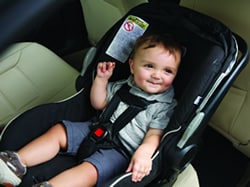
We can reduce the risk of serious injuries and death by making sure children are properly buckled in car seats, booster seats, and seat belts that are appropriate for their age and size.
- Car seat use reduces the risk for injury in a crash by 71–82% for children, when compared with seat belt use alone.27,28
- Booster seat use reduces the risk for serious injury by 45% for children ages 4–8, when compared with seat belt use alone.29 Also, a more recent study found that the effectiveness of booster seats may be even higher than 45%. The newer study also found that booster seats help prevent moderate and serious crash injuries among children ages 7–8.30
- Seat belt use reduces the risk for death and serious injury by about half for older children and adults.1,31
Child restraint laws require children riding in vehicles to be buckled up in approved restraints such as car seats, booster seats, or seat belts appropriate for their age, weight, and height. These laws are effective for increasing restraint use and reducing child deaths and injuries.32–34
-
- Strengthening current laws with booster seat provisions that require children who have outgrown car seats to use booster seats until at least age 9 helps reduce injuries and deaths.10,21,35–39
- Children ages 4–8 years in states with booster seat laws were over four times as likely to be using age-appropriate restraints and were 20% less likely to die in crashes than children in states without booster seat laws.36
- A study among children (including booster seat age children) involved in crashes found that restrained children were 66% more likely to be buckled in appropriate restraints if their state law followed best practice recommendations.21
- Observed booster seat use among children ages 4–7 years increased from 24% to 43% after booster seat laws were implemented in Milwaukee County, Wisconsin.37
- The crash death rate among 7-year-olds was 25% lower for children in states with booster seat laws covering 7-year-olds compared with states without booster seat laws covering 7-year-olds.38
- The rate of children using car seats and booster seats increased nearly three-fold in five states that increased the booster seat use age requirement to 7 or 8 years. The rate of children who sustained fatal or incapacitating injuries decreased by 17% in these states.39
- Multiple studies in Canada also demonstrate the effectiveness of strengthening current child restraint laws with booster seat provisions.40,41
- As of September 2022, only 5 states require children to use booster seats until at least age 9. CDC’s Booster Seat Planning Guide can assist with assessing, planning, and implementing improved booster seat laws.35
- Short-term, high-visibility enforcement programs can enhance the effectiveness of child restraint laws, especially if they include broad media coverage.32,34 These programs are often similar to or conducted in combination with seat belt use programs like Click It or Ticket.
- Strengthening current laws with booster seat provisions that require children who have outgrown car seats to use booster seats until at least age 9 helps reduce injuries and deaths.10,21,35–39
- Car seat and booster seat distribution plus education programs can also increase restraint use.32,42,43 These programs help parents and caregivers get new, unused car seats or booster seats and learn how to properly install and use them.32,42,43 These programs often include hands-on demonstrations which can help increase proper installation and use.
- Incentive and education programs reward parents or children with coupons or other prizes for correctly using car seats and offer educational print materials and videos for parents and caregivers.32,34,42
Guidelines for Parents and Caregivers
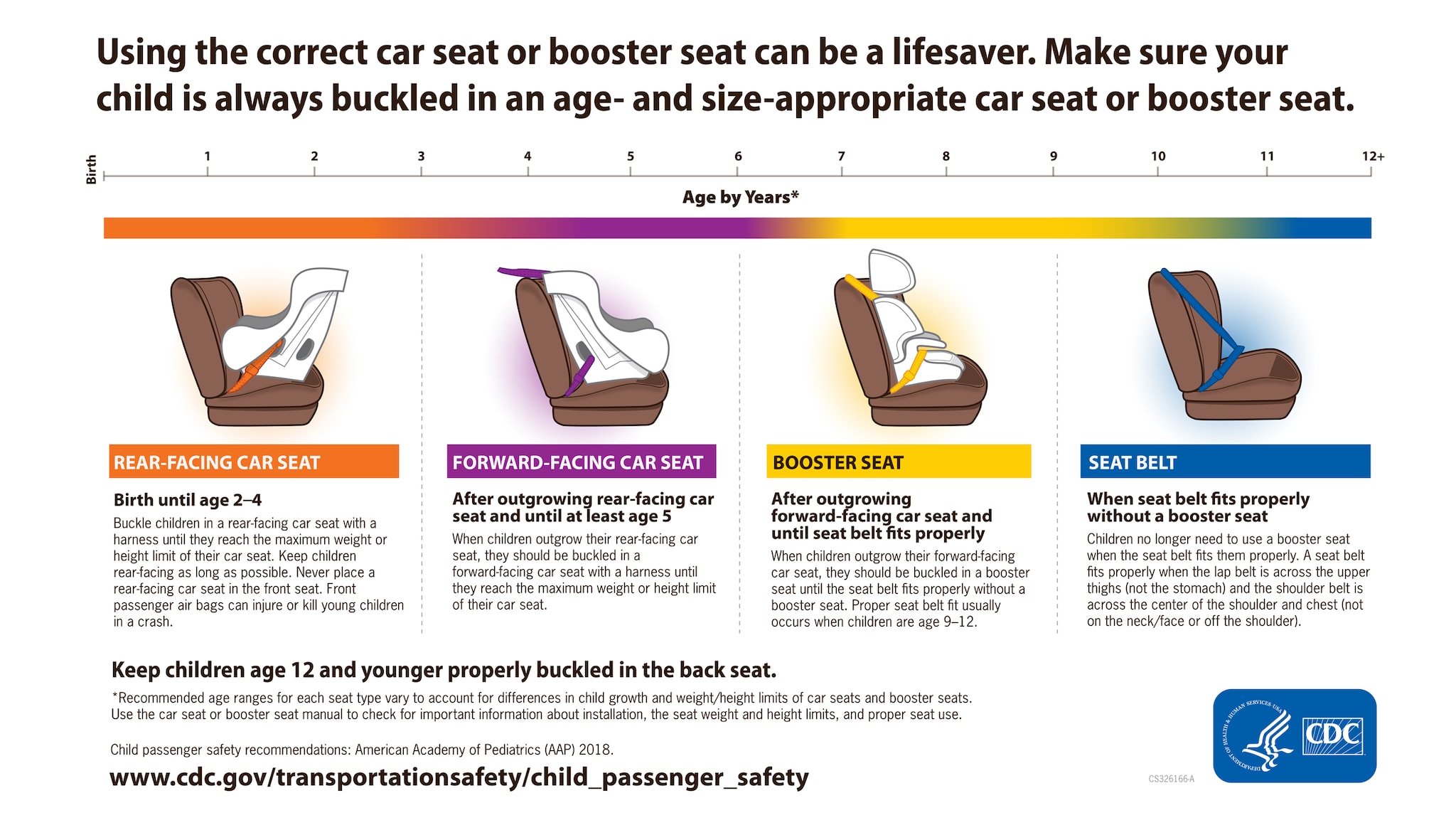
Know the Stages
CDC provides guidance to ensure children are properly buckled in a car seat, booster seat, or seat belt—whichever is appropriate for their age, weight, and height.
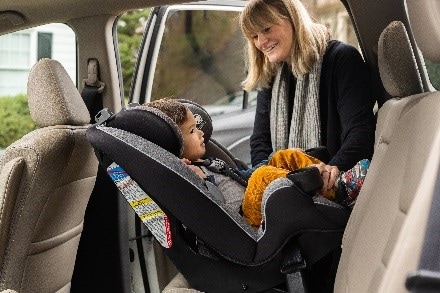
Stage 1. Rear-facing car seat: Birth until ages 2–4.
Infants and toddlers should be buckled in a rear-facing car seat with a harness, in the back seat, until they reach the maximum weight or height limit of their car seat. This offers the best possible protection.44,45 Check the car seat manual and labels on the car seat for weight and height limits.
Never place a rear-facing car seat in the front seat. Front passenger air bags can injure or kill young children in a crash.
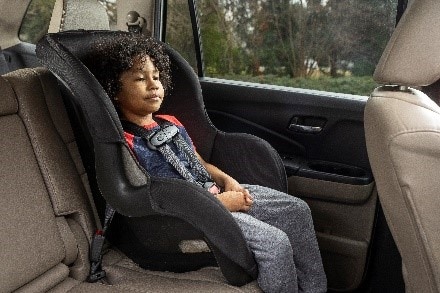
Stage 2. Forward-facing car seat: After outgrowing their rear-facing car seat and until at least age 5.
When children outgrow their rear-facing car seat, they should be buckled in a forward-facing car seat with a harness and a top tether, in the back seat. They should stay in their forward-facing car seat until they reach the maximum weight or height limit of their seat. Check the car seat manual and labels on the car seat for weight and height limits.
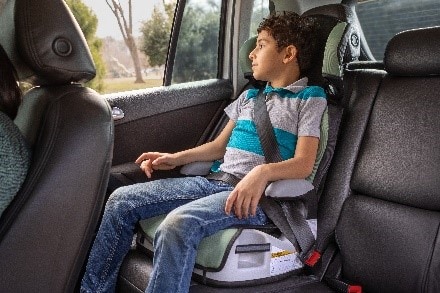
Stage 3. Booster seat: After outgrowing their forward-facing car seat and until the seat belt fits properly.
When children outgrow their forward-facing car seat, they should be buckled in a belt-positioning booster seat with a seat belt, in the back seat. They should continue to use a booster seat until the seat belt fits properly without a booster seat. A seat belt fits properly when the lap belt is across the upper thighs (not the stomach) and the shoulder belt is across the center of the shoulder and chest (not across the neck or face, and not off the shoulder). This usually occurs when children are between 9 and 12 years old.
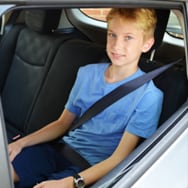
Stage 4. Seat belt: When the seat belt fits properly without a booster seat.
Children no longer need to use a booster seat when the seat belt fits them properly. A seat belt fits properly when the lap belt is across the upper thighs (not the stomach) and the shoulder belt is across the center of the shoulder and chest (not across the neck or face, and not off the shoulder). This usually occurs when children are between 9 and 12 years old.
- Seat belt fit can vary by vehicle so check seat belt fit in all vehicles where the child will ride to make sure the child no longer needs to use a booster seat. Sometimes a child might need a booster seat in one vehicle but not in a different vehicle.
- Keep children properly buckled and in the back seat through age 12 for the best possible protection.44
Car Seat, Booster Seat, and Seat Belt Tips
- Install and use car seats and booster seats properly on every trip.Check the car seat or booster seat manual for instructions.
- Be sure to check for
- A correct recline angle for rear-facing car seats.
- A tight installation for all car seats.
- Installed car seats should move no more than one inch from front-to-back and from side-to-side at the belt path.
- A tight harness that is not behind the child’s arms, legs, or back for all car seats.
- Do the “pinch test” to ensure the harness is tight enough. If you can pinch the harness straps between your fingers at the child’s shoulders, this means that the harness is too loose.
- A harness chest clip that is at the child’s armpit level.
- Proper seat belt fit for children using booster seats or the seat belt alone.
- Make sure the lap belt is across the upper thighs (not the stomach) and that the shoulder belt is across the center of the shoulder and chest (not across the neck or face, and not off the shoulder).
- Be sure to check for
- Help is available! Get help installing car seats and booster seats from certified child passenger safety technicians. They are trained to provide education and hands-on assistance for all types of car seats and booster seats. These services are usually free.
- Find a certified child passenger safety technician near you.
- Find a local car seat inspection station near you. Some now offer virtual appointments in addition to in-person appointments.
- Don’t seat children in front of an air bag. Air bags can kill young children riding in the front seat. Never place a rear-facing car seat in front of an air bag.
- Buckle children in the middle of the back seat when possible.44 This is generally the safest position in the vehicle since it is the farthest point from an impact coming from any direction.
- If the middle seating position contains only a lap belt, older children using booster seats or seat belts should sit in a different seating position in the back seat where they can use both a lap and shoulder belt.
- Most rear-facing and forward-facing car seats can be safely installed in the middle seating position using the lap belt only.
- Use the top tether with forward-facing car seats.46,47
- A top tether can reduce a child’s head movement in a crash by about 4–6 inches.46,47
- A top tether should be used regardless of whether the forward-facing car seat is installed with the lower anchors or with the seat belt.
- Ensure that children ages 12 and younger are properly buckled in the back seat.
- Always make sure that older children who use booster seats or seat belts are buckled with both the lap and shoulder belt. Both the lap and shoulder belt are needed for proper protection.
- Use proper restraints on every trip.
- Buckle children in car seats, booster seats, or seat belts on every trip—no matter how short the trip may be.
- Parents and caregivers can set a good example by always wearing a seat belt.
Considerations for Children with Special Needs
- The American Academy of Pediatrics offers guidance on transporting children with special health care needs.
- Some child passenger safety technicians (CPSTs) receive additional training to provide education and assistance for transporting children with special needs.
- Find a CPST with this training by selecting the “Special Needs” option in the “Extra Training” search box.
- Some large hospitals and other health care facilities have CPST staff members who have received special needs training and are available to help.
Learn How to Prevent Hot Car Deaths Among Children
* On this webpage, child passenger refers to any child who was killed in a traffic crash as a passenger vehicle occupant. Passenger vehicles include passenger cars and light trucks.
† Restraint status was known for 549 of the 607 child passenger vehicle occupants ages 12 and younger who were killed in crashes in 2020. Among the 549 child passengers for which restraint status was known, 211 (38%) were unrestrained.
§ Restraint status was known for 197 of the 219 child passenger vehicle occupants ages 8–12 who were killed in crashes in 2020. Among the 197 child passengers (ages 8–12) for which restraint status was known, 79 (40%) were unrestrained. Restraint status was known for 166 of the 181 child passenger vehicle occupants less than 4 years old who were killed in crashes in 2020. Among the 166 child passengers (less than 4 years old) for which restraint status was known, 52 (31%) were unrestrained.
¶ These percentages are based on child passenger vehicle occupants for which restraint status was known.
** The Quinlan et al. study assessed drivers with a BAC ≥0.08 g/dL. The Huang et al. study assessed drivers who tested positive for alcohol. About 22% of these drivers had a BAC lower than ≥0.08 g/dL.
†† These percentages are based on child passenger vehicle occupant and driver dyads for which restraint status was known.
Related Pages
- CDC Feature Article: Child Passenger Safety
- What Works: Strategies to Increase Car Seat and Booster Seat Use
- Booster Seat Planning Guide
- Buckle Up: Restraint Use State Fact Sheets
- CDC Child Passenger Safety Graphics: How to Avoid the Most Common Mistakes
- Publications
Additional Information
- Find a child passenger safety technician
- Find a car seat inspection station
- National Highway Traffic Safety Administration: Child Safety Information for Parents and Caregivers
- American Academy of Pediatrics (AAP) Links:
- AAP website for parents (Healthychildren.org): Car Seats: Information for Families
- AAP Child Passenger Safety Policy Statement
- AAP Child Passenger Safety Technical Report
- Insurance Institute for Highway Safety (IIHS) Links:
- CDC’s Early Care and Education Portal – Safety, Health, and Injury Prevention
- Access this portal to learn more about how early care and education providers can keep children safe and healthy and prevent injuries among children










